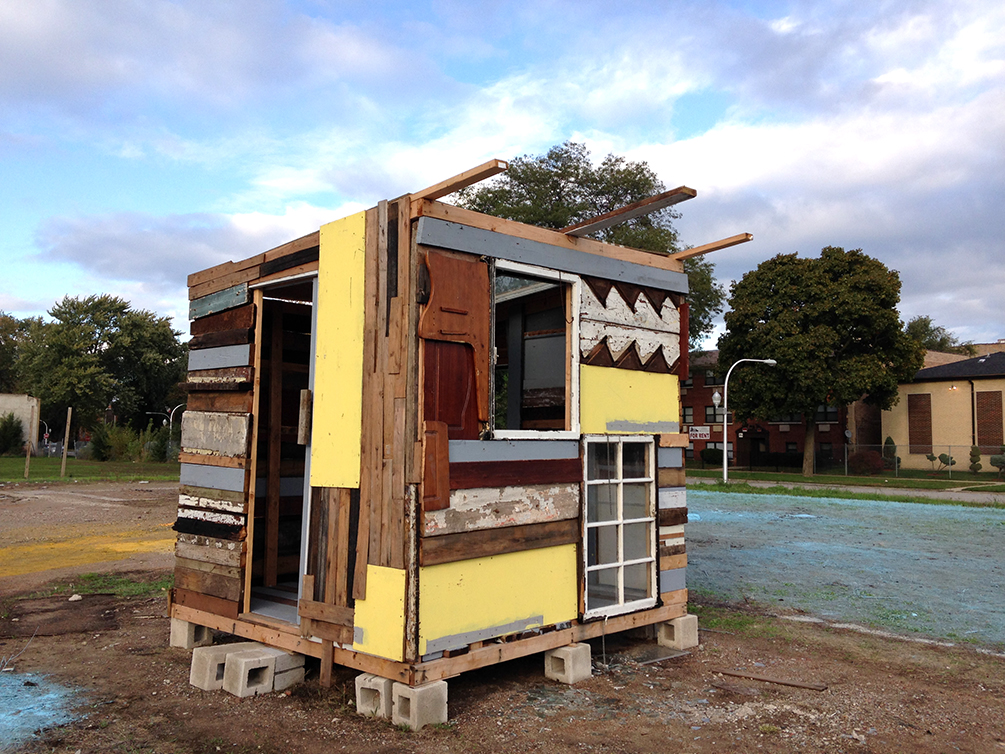
At the northwest corner of the intersection between 71st Street and East End Avenue stands a wooden structure, a shack—something less akin to a building than an overgrown wooden crate marked with a modernist interpretation of tribal designs. The walls are cobbled together from boards, some newly painted pastel yellow, others black, with mahogany and aged pine planks filling in the gaps. The roof falls about four inches short of covering the whole floor on the southern side, leaving something to be desired for anyone who might come to the shack looking for protection from the elements. But as one neighborhood resident put it, “sometimes you just need a place to cry,” and as a personal refuge and a social catalyst the shack may appear oddly placed, but it is well equipped.
The artist responsible for this project, aptly titled “Shacks and Shanties,” is UIC professor Faheem Majeed. He chuckles cheerfully as he recounts that some carpenters passing by for the first time considered it an artist’s misadventure in the trade of constructing inhabitable spaces. Majeed is not focused on his creations as ends in and of themselves—they are not autonomous art objects, nor is “Shacks and Shanties” a neighborhood beautification project. But it is a neighborhood improvement project of sorts. “The idea is that the shack is temporary…what’s sustainable is the relationships. So it’s like, temporary structures creating sustainable networks and relationships.”All summer and into autumn the two shacks, one in Bronzeville and one in South Shore, have functioned as pop-up galleries, with a steady and highly varied stream of artists staging exhibitions and performances on these formerly-deserted lots. All have excitedly embraced the limitations and new possibilities that come with this attempt to create art within walls that belong to neither museum nor gallery. Artist Amanda Williams spread a line of bright yellow paint across the 71st Street lot over the uneven stubbly grass, jumping at the chance to make an artistic statement about Safe Passage in a medium that has a larger reach within the South Shore audience than almost any canvas.
And as the clouds threaten rain on an October afternoon, an elementary school boy in a puffy purple jacket spontaneously performs with the painting. Quibbling with his older sister and rejecting her hand, he struts confidently alone down that line across the lot. Its floor of barley-brown and grayed periwinkle boards sits above the ground on cinder blocks, making the 71st Street shack a platform in both the literal and figurative sense.
Majeed is fully aware of this function. He describes the shacks as the manifestation of his desire to bring together his work as an artist and a curator. “A lot of my art is still about making, but it’s about making platforms…I am always thinking about how I can fuse together interesting individuals to do things in a public space where maybe there wasn’t one already. Which is why I decided to move into the vacant lots.”
The Bronzeville shack that Majeed erected on 48th Street currently houses an exhibition of work by local artist Liz Mares. Like the shacks themselves, her medium is recycled materials, colored by a history of human use. Paper placards announcing the importance of human impact on the water supply are wrinkled and bear stains from recent rains, almost obscuring their statements. But the paper and cloth-filled plastic bottles that populate the shack are positioned to draw an observer into a confrontational interaction with the public. Just inside the door they compete with visitors’ feet for space at every step, and Mares is delighted to find that the installation’s parts have been knocked over and displaced.
The focus of “Shacks and Shanties” on giving new life to everyday materials is perfectly integrated with the story of the shacks themselves, further blurring the line between art and functional space. “The shacks are made of recycled materials, found materials from dumpsters in the neighborhoods that I’m in. And the idea is that the shack will eventually go back into the dumpster,” Majeed says. “The idea [is that] we are working in shacks now, and then we are going to throw the shacks away, and then we are going to do something else next summer, or the next summer.”

I love this! It reminds me of the prototypical shack built by most converts to Rastafarianism when they start the journey of rejecting ‘Babylon ‘. Casting the mind further afield, the huts is a psychic cousin to the “chattlel huts” dotting the rue tal landscapes of the Wasrern Caribbean”. Their endurance stands in ironic testament to the legal impermanence they are supposed to represent.